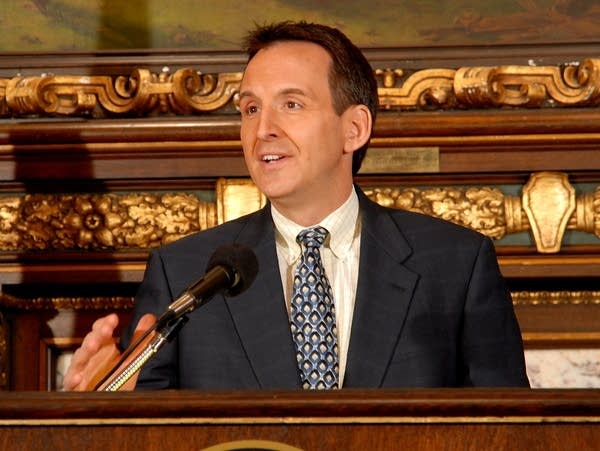Pawlenty set to release his list of budget cuts
Go Deeper.
Create an account or log in to save stories.
Like this?
Thanks for liking this story! We have added it to a list of your favorite stories.

Gov. Pawlenty will announce Tuesday afternoon exactly where he intends to cut spending to balance the state's budget. He's scheduled a 2 p.m. news conference to outline his budget plans.
Last month, Pawlenty said he will use his emergency authority, called unallotment, to erase a $2.7 billion budget deficit after he failed to reach a budget agreement with Democrats in control of the Legislature.
On Saturday, Gov. Pawlenty bragged to a group of Republican activists that his spending cuts would be unprecedented.

"The state of Minnesota has never -- since 1858 as far as we can find, in 151 years of history in the state of Minnesota, in a biennial budget -- never has the budget gone down, until this year," he said.
Turn Up Your Support
MPR News helps you turn down the noise and build shared understanding. Turn up your support for this public resource and keep trusted journalism accessible to all.
The action is unprecedented for another reason. The law allowing a governor to cut spending unilaterally is usually used near the end of a two-year budget cycle, not at the start of the biennium to set a budget.
Pawlenty has said his cuts will include aid to local governments, health and human services programs and higher education. Pawlenty declined to offer specifics after his speech on Saturday, but said there wouldn't be any major surprises.
"There isn't any real mystery as to what's boxed off because the federal government won't allow us to touch it," said Pawlenty. "And we've committed to try to only defer, and not permanently reduce, school payments, and that leaves the other categories."
"[Pawlenty] says he wants to have input. We're going to give him some input."
The governor plans to consult with state lawmakers and a variety of stakeholders about his plan. By law, his administration has to consult with legislative leaders -- but he doesn't need to get their approval. That group, known as the Legislative Advisory Commission, is scheduled to meet on Thursday.
DFL House Speaker Margaret Anderson Kelliher said the hearing will focus on the impact the cuts will have on Minnesotans.
"It's unclear to me how serious the governor is about taking the input and making any changes to his plan," said Kelliher. "He says he wants to have input. We're going to give him some input."
Kelliher said it's very likely that a lawsuit will be filed to try to stop the cuts. She said she has met with officials from hospitals, nursing homes and cities.
Some groups, including the Minnesota Hospital Association, said they're examining their legal options.
Heidi Conrad, chief financial officer for St. Paul-based Regions Hospital, said she's worried about more cuts to the hospital system -- especially, she said, because the governor line-item vetoed a health insurance program for poor people last month.
"It's devastating for us to be facing these kinds of cuts, knowing that these patients will still need care," said Conrad. "And we will want to, as would the rest of the community, respond and be able to provide them the care that we believe everyone has the right to."
Officials in cities around Minnesota are also bracing for cuts in state aid. Pawlenty initially proposed cutting $325 million in aid to cities over the next two years. That's on top of the $66 million in aid to cities Pawlenty cut in December.
Gary Carlson with the League of Minnesota Cities said local officials are nervous about more funding cuts, because they've already cut core services. He said cities will be forced to raise property taxes and make additional budget cuts if state aid is dramatically reduced.
"We have been in the target. There's no doubt about it," said Carlson. "When cities receive aid, it doesn't have an overt benefit to taxpayers. We know that those programs help keep property taxes down. But the reality is the governor is going to call upon us. We do have a bull's eye on our back."
Pawlenty has said there is no reason cuts in state aid should automatically result in property tax increases at the local level.
The governor has also said he intends to protect funding for schools. But he said he'll try to delay some payments.
Charlie Kyte of the Minnesota Association of School Administrators says the payment delays will have a financial impact on school districts.
"A lot of school districts will have less money in reserves that can be invested, or they'll have to go out into the marketplace and borrow money to cover their cash flow needs," said Kyte. "And the cost ... from lost interest or having to pay interest if they're borrowing, we estimate will come to $30 per pupil unit across the state."
MnSCU Chancellor James McCormick says he expects most of the higher education cuts will be felt in the second year of the biennial budget, which would give lawmakers time to come back next session and find more funding.
The governor's announcement does not mean the cuts will go into effect right away. By law, the governor can't cut spending on his own until July 1, which is the start of the new fiscal year.



